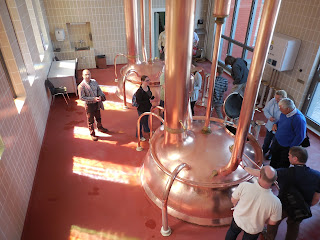As recent years have seen the closure of a lot of pubs I thought I'd look into how many local to me have closed and what I thought of them. I've managed to find a dozen, and I'd drunk in all of them save one.
First on my list is the Goldsworth Arms. I only went here once when a band were playing. I think a friend of a friend was in the band, and I can remember they played
Gordon is a moron as we had to call up our mate of that name so we could shout it down the phone at him. The pub looked grotty and I can't say I'm surprised it closed. After years of closure scaffolding has recently appeared around it so they're doing something with it, thought I doubt that it's reopening it as a pub.
 |
| The Goldsworth Arms |
Moving on there's a load of flats where The Cotteridge Hotel used to be. I drank here a few times, both when it was the Cotteridge and when it was later the Litten Tree. It seemed a perfectly fine place to drink in, though I did get barred once. Not my fault of course, it was all due to my girlfriend of the time being keen on a dried flower display but that's another story.
 |
| The Cotteridge |
Moving on to Old Woking we have more flats where the Queen's Head used to be. I drank here a lot in my youth. It was owned by Courage then, though Moorlands later took it over. It was a two bar pub with a large garden. I hadn't been there in years when it closed but a mate nearby was annoyed as he would still drink in it, unlike another pub nearby.
 |
| The Queen's Head, Kingfield |
Further down the road was the White Hart, I suspect it was a bit too far out to have got much passing trade. I only ever drank here once and it looked like an old style two bar boozer. I only had a pint but it was pleasant enough. Currently surrounded by scaffolding prior to be turned into housing.
 |
| The White Hart |
The only pub on my list I didn't go to was The College Arms, another one that's been knocked down and replaced with flats. It's close to the mosque so a lot of muslims live nearby. This may not have helped its chances of survival, as the muslim sky wizard is famous for his antipathy to alcohol. Though as Woking has
Britain's oldest mosque having a lot of muslims nearby is hardly a new development.
 |
| The College Arms, Maybury |
Back in the town centre was the Rat and Parrot. I had the misfortune of going to this shit hole twice. A large keg only establishment full of kiddies it was apparently shut down due to under age drinking. I once heard a colleague say she'd seen a couple shagging whilst they were sat at one of the tables. Classy, eh?
 |
| The Rat and Parrot |
Opposite the station there's a nightclub called The Bed. I went to it a few times when it was called something else, though at the moment what the name was escapes me. I only ever went when pissed so maybe that's why the names gone. You certainly wouldn't want to have gone there sober though.
It was for a while an American style brew pub. I never went to it then as the beer was served from tanks under pressure and I had no time for such filth. If you think I'm a dogmatic follower of the CAMRA party line now you should have seen me in my youth!
 |
| The Bed |
Back out to Westfield what was once The Cricketers is now a Chinese restaurant. I drank in this pub a lot when I was younger. It used to put on crappy local bands, though given the size of the egos some of the band members had you'd have thought they were playing Wembley stadium. It was a Courage pub so Directors was the drink of choice as I was never keen on Best.
 |
| The Cricketers |
|
Going out to Bisley the Fox Inn is now more housing. I only drank here once and sat in the garden so can't recall anything else about the place, though it always looked a bit tatty when I drove past.
 |
| The Fox Inn, Bisley |
Handily placed for Brookwood station was The Brookwood. I went here twice, the first time when I had long hair and it was a squaddies pub. The hostile comments started as soon as I got to the bar so some very rapid drinking was soon followed by a hasty exit. Many years later I ended up here whilst on a very boozy family walk with another ex. We must have been pretty far gone and the beer must have been crap as we all ended up having a Baileys. It looks like it's offices now.
 |
| The Brookwood, Brookwood |
Back at the top of Wych Hill there's The Star. I only went here once to check it out after it had been refurbished. Sadly refurbished meant no carpets or anything else that might deaden the sound making it too damn noisy. I never returned and now it looks like I never will.
 |
| The Star |
Lastly there's place that was much more bar than pub, another of those horrible keg only, bare floorboard buildings that are best avoided by discerning drinkers. It traded under a number of names, but was called Mojos when it finally lost it's mojo and closed for good.
It's not all been closures though, I can remember when the Wetherspoons was a Woolworths and two other pubs have opened in the town centre and are still running. Still a big net loss, and though some were awful others were perfectly decent pubs.











































